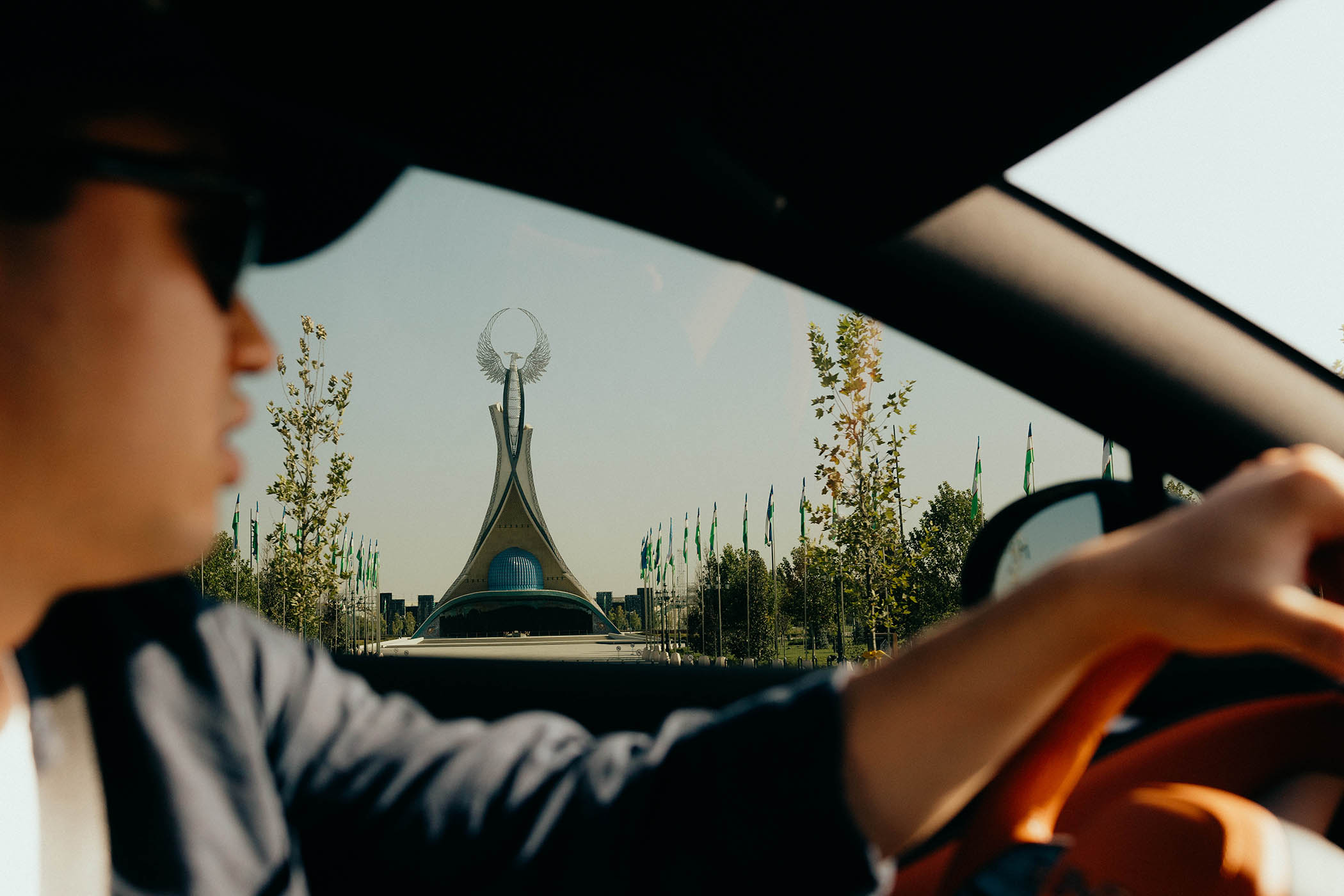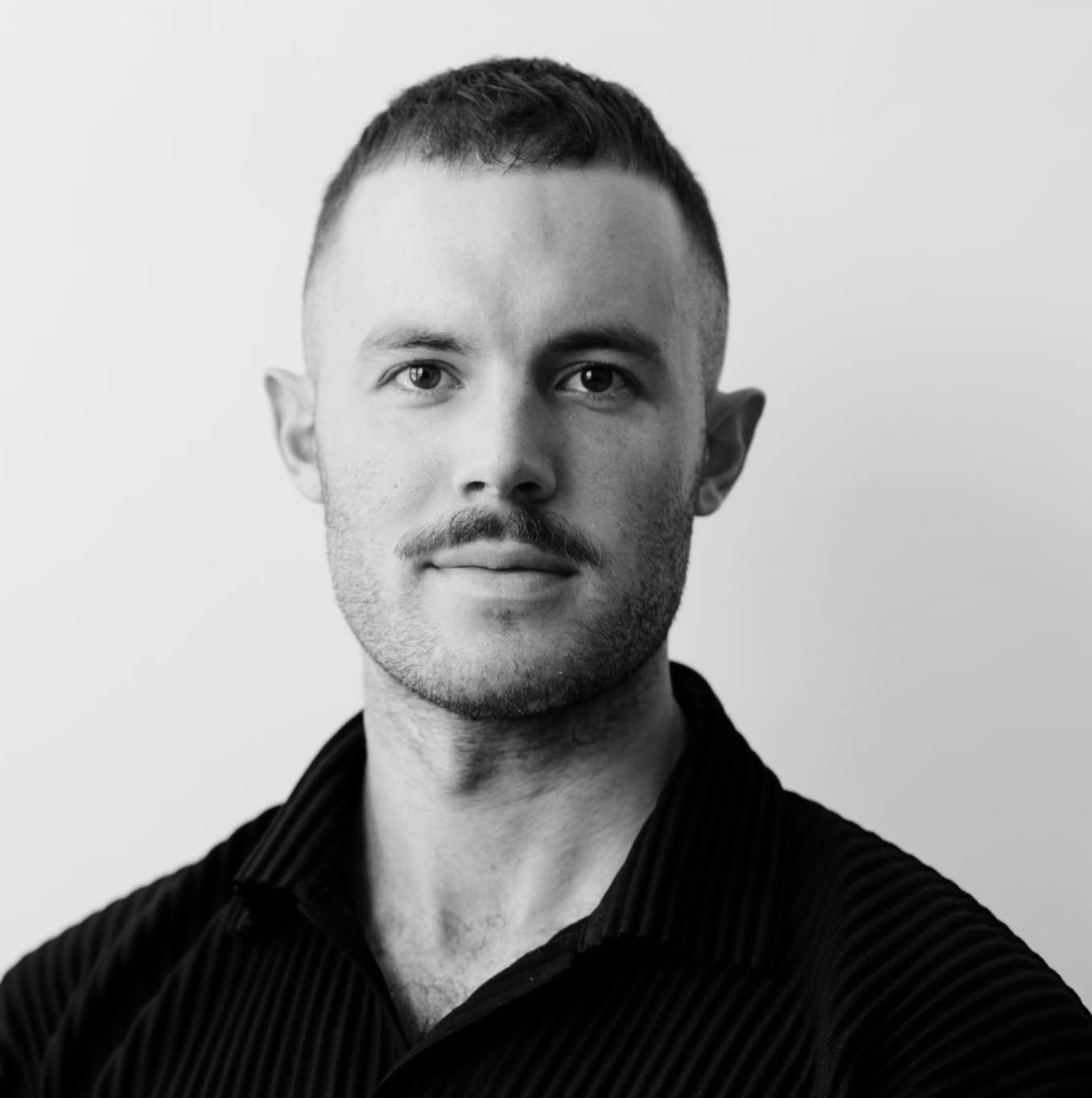Photographs Alex Bingham
Up a dry mountain pass an hour’s drive east of Tashkent, we finally saw it, hovering like a silver spaceship on the horizon. The Uzbekistan Solar Furnace turns its back on Parkent Valley, a series of tin-roofed villages along a parched riverbed, where more than once we had to brake for a cow in the road. A Soviet-era research facility, the furnace seems fantastically out of place: 70m of mirror-plated steel, curved like a sail billowed by interstellar winds, a relic of some future past. At its centre, rays of sunlight gather into a single beam that is as wide as a tree-trunk and which burns at 3,000C, enough to vaporise a person’s bones in milliseconds. Luckily, we’d packed extra pairs of shades.
The “heliocomplex” was one of the last major scientific projects established by the USSR when it was completed in 1987. Back then it was a top-secret facility patrolled by armed guards. When we arrived, on a blistering 40C day in early September, there was no one else around save for our guide, an engineer in jeans and a baseball cap, who told us that the “sun gun” is now run by Uzbekistan’s Academy of Sciences for materials testing. We ran our fingers over carbon fibre panels and ceramic-infused plastic. On an indoor mezzanine, Cyrillic keyboards gathered dust. Below us a giant chandelier of fiery orange glass hung unlit above the black marble floor of an empty lobby.
This was no sterile basement laboratory in its heyday but a glittering example of Soviet largesse in one of the Union’s farther-flung satellite republics, and a monument to space-age modernism at its most flamboyant. Now, it mostly appeared to be a home for starlings, which flitted noisily through gaps between the mirrored panels on the parabolic structure. Our guide shrugged when I asked if they ever burst into flames.
Before we departed, he asked if we’d like a demonstration. Not from the big blaster, of course, but from one of the smaller test devices on the complex, which resembled disco-ball satellite dishes. It would cost 100,000 som, he said, or £6. When we paid, an older gentleman in an embroidered skull cap and welder’s goggles emerged from a trapdoor. Bare-handed, he threw heavy building materials into the beam of light. Wood became ash. Bricks turned to glass. A coin? Surely we had something that wasn’t Uzbek to melt, he pleaded, looking worried. The face of George Washington or Queen Elizabeth would do.
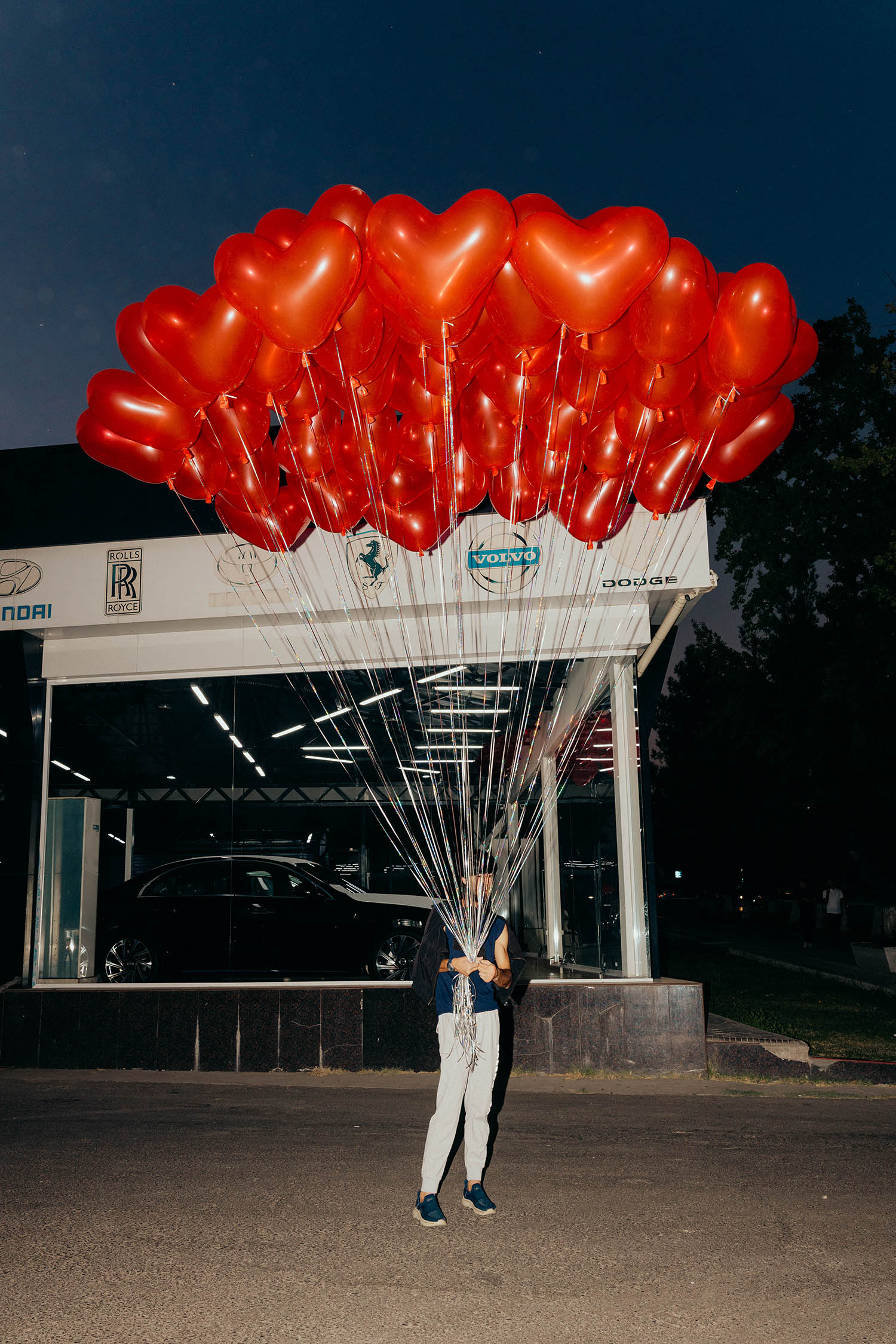
Show some love: a balloon seller in Tashkent
Perhaps he was right to be apprehensive. I had come to Uzbekistan with many other journalists as a guest of the country’s president, Shavkat Mirziyoyev, though the invitations had been issued far down the food chain. The autocrat has been in office since 2016 – where, following a constitutional referendum, he is eligible to remain until 2037 – but he has been a fixture of Uzbek politics since before the country gained its independence in 1991. In the 00s, he was prime minister to Islam Karimov, a brutal ex-apparatchik notorious for boiling dissidents alive. For decades, Uzbekistan was a pariah: economically isolated, doubly landlocked, more than 85% desert, its resources – chiefly gas, gold and cotton – relatively untapped. Capital punishment was legal here until 2008. The government required its citizens to apply for exit visas until 2019.
But Mirziyoyev, I was told, had changed. Touched by a reformist zeal and an appetite for international investment, he has spent the past several years reinventing his country, and opening it up: banning child and slave labour, outlawing gender-based violence, gradually shifting the state-planned economy to a market system.
We’d come for a kind of proof: the inauguration of a new Centre for Contemporary Art (CCA) in Tashkent and an art biennial in Bukhara, as well as the groundbreaking of a sprawling National Museum designed by Tadao Ando. These join at least half a dozen other museum projects across the country, designed by “starchitect” studios such as Zaha Hadid and Lina Ghotmeh. Much of Uzbekistan’s older brick and blue-tiled architecture has been carefully renovated, including, in Samarkand, the Gur-e-Amir, or mausoleum of Timur, the fearsome 14th-century conqueror known in the west as Tamerlane. Samarkand is preparing to host the 43rd general session of Unesco this November, the first to take place outside Paris in 40 years.
From the outside, Mirziyoyev’s reforms appear to be working. Foreign investment increased by more than 60% last year. Much of it comes from Russia and China, but plenty more comes from Saudi Arabia, a top purchaser of Uzbek gold. And people are visiting. Tourism from the UK is up nearly 24% year-on-year, though numbers remain reasonably low: 9,100 Brits visited the country between January and May this year. (For comparison, 1.3m UK tourists visited Turkey, a country Uzbekistan might aspire to consider a tourism rival, during the same period.) Last year Uzbekistan Airways introduced twice-weekly flights to Tashkent from both Heathrow and Gatwick.
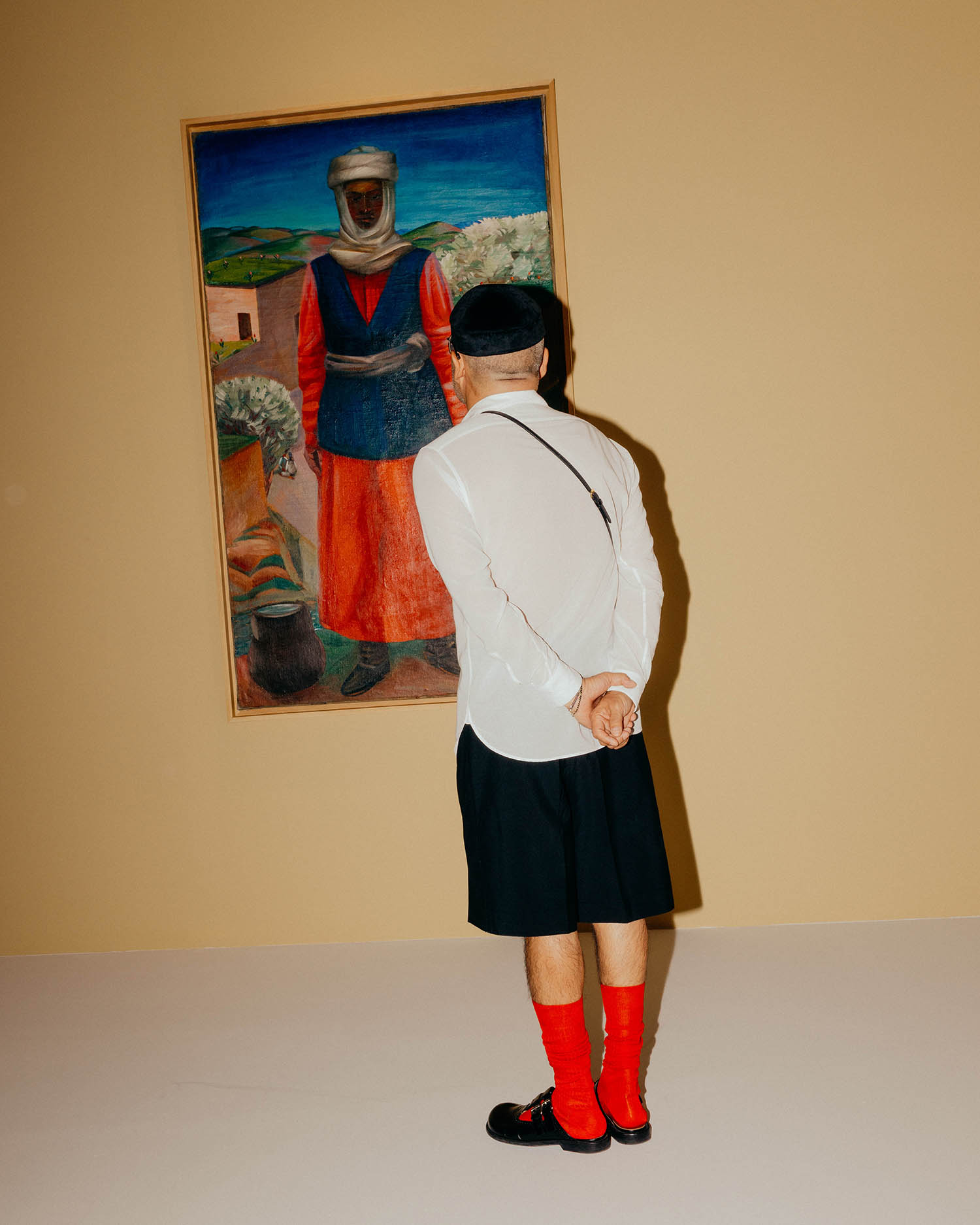
In the frame: a visitor examines a painting at the Art Gallery of Uzbekistan
More people are travelling now than before the pandemic, and tourist destinations are struggling to cope. The Greek islands are packed through the summer. Long queues at Kyoto’s Fushimi shrine recently flooded social media (there were reports of visitors chasing geishas down the street). Central Asia is an appealing alternative for more intrepid travellers, with its rich and ancient history, its rugged natural landscapes, its emptiness when compared to Venice. Friends of mine have been going: one, a retired woman in her 70s, visited last year with her husband after completing a course at Soas on Central Asian textiles. Another went with his boyfriend to ride horses through the desert. (They had no trouble, although homosexuality is punishable by a maximum three-year prison sentence. My own boyfriend told me to say my “wife” was in Hackney, should anybody ask.) My flight was full of silver-haired pensioners I imagined to be on the hunt for kilim rugs and Sufi pottery. Or maybe they were on their way to see Timurid architecture. Whatever the case, the Uzbek government is after their pound.
From my seat on the sidelines, drinking the second-tier wine, it all looked like the hard launch of a soft-power strategy
I arrived late to the inaugural gala dinner for CCA Tashkent. Candlelit tables filled the restored 19th-century railway depot, still a live construction site. The president’s eldest daughter, Saida Mirziyoyeva, arrived 30 seconds later. I was pinned against the wall of the building by her security guards as she emerged from a limousine, ears encrusted in diamonds. She was greeted by her childhood friend, Gayane Umerova, Chair of the Uzbekistan Art and Culture Development Foundation (ACDF), the public body bankrolling the new museums and biennial. The two women cut a striking image – young, beautiful and elegantly attired – more Selling Central Asia than government bureaucrats.
Appointed chief of staff in late June, with a dizzying portfolio that includes business, education, health-care, the judicial system and water resources, Mirziyoyeva also seems to have survived a succession battle within her own family. Last October, two Chechens allegedly hired by her brother-in-law opened fire on her political mentor, Komil Allamjonov, as he sat in his car in a suburb of Tashkent. The assassination attempt has dominated national news for much of the past year. It also dominated conversation at the underdressed press table, where I hid my scrappy shoes, still dusty from Parkent.
While a kilted Scottish DJ, flown in for the occasion, played loud techno remixes of bagpipe music, Mirziyoyeva posed for photographs with the British influencer known as Gstaad Guy, whose smirking Instagram posts parody the global elite. “He took a helicopter to the solar furnace,” one of my neighbours said. She greeted Saudi emissaries from the Royal Commission for AlUla and Diriyah Biennale Foundation, arts organisations central to Crown Prince Mohammed bin-Salman’s 2030 vision for the kingdom and perhaps the closest model for the ACDF. Moments later, Mirziyoyeva assumed her seat beside the US ambassador, who had managed to set up a call between her father and Donald Trump earlier that afternoon.
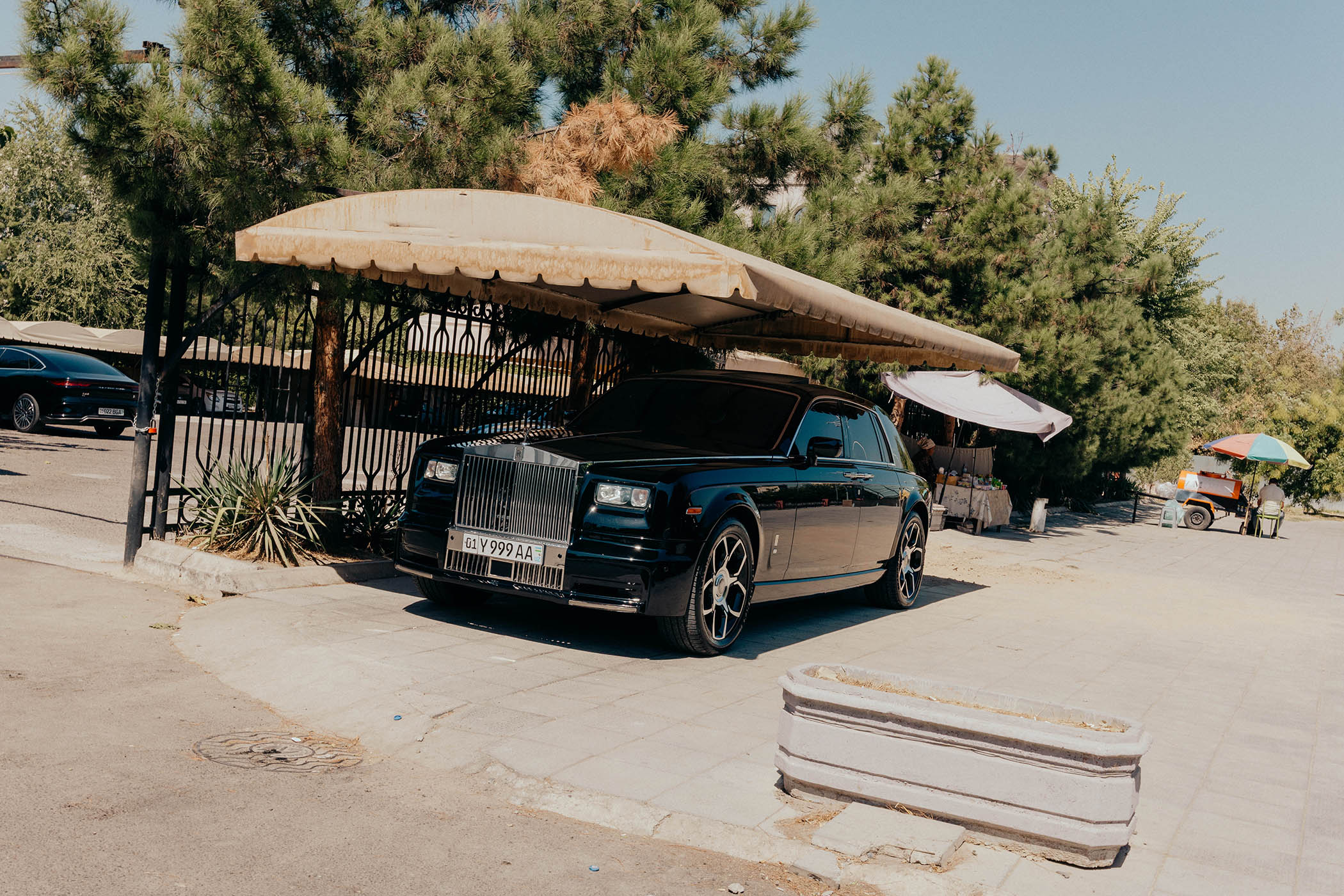
Shady customer: a Rolls-Royce keeps cool from the desert sun
“In this country, 65% of the population is under 35,” Sara Raza, the CCA director, mentioned in her toast, noting that the museum would open opposite Tashkent State University. Young people need creative outlets and professional opportunities, she said. Students have recently toppled governments in Bangladesh and Nepal. It’s not surprising that Mirziyoyeva is eager to appease them.
From my seat on the sidelines, drinking the second-tier wine, it all looked like the hard launch of a soft-power strategy. A proposal for how a small country might outmanoeuvre the hostile superpowers at its flanks. And a pitch that the beating heart of the ancient Silk Road should return to the centre of global trade.
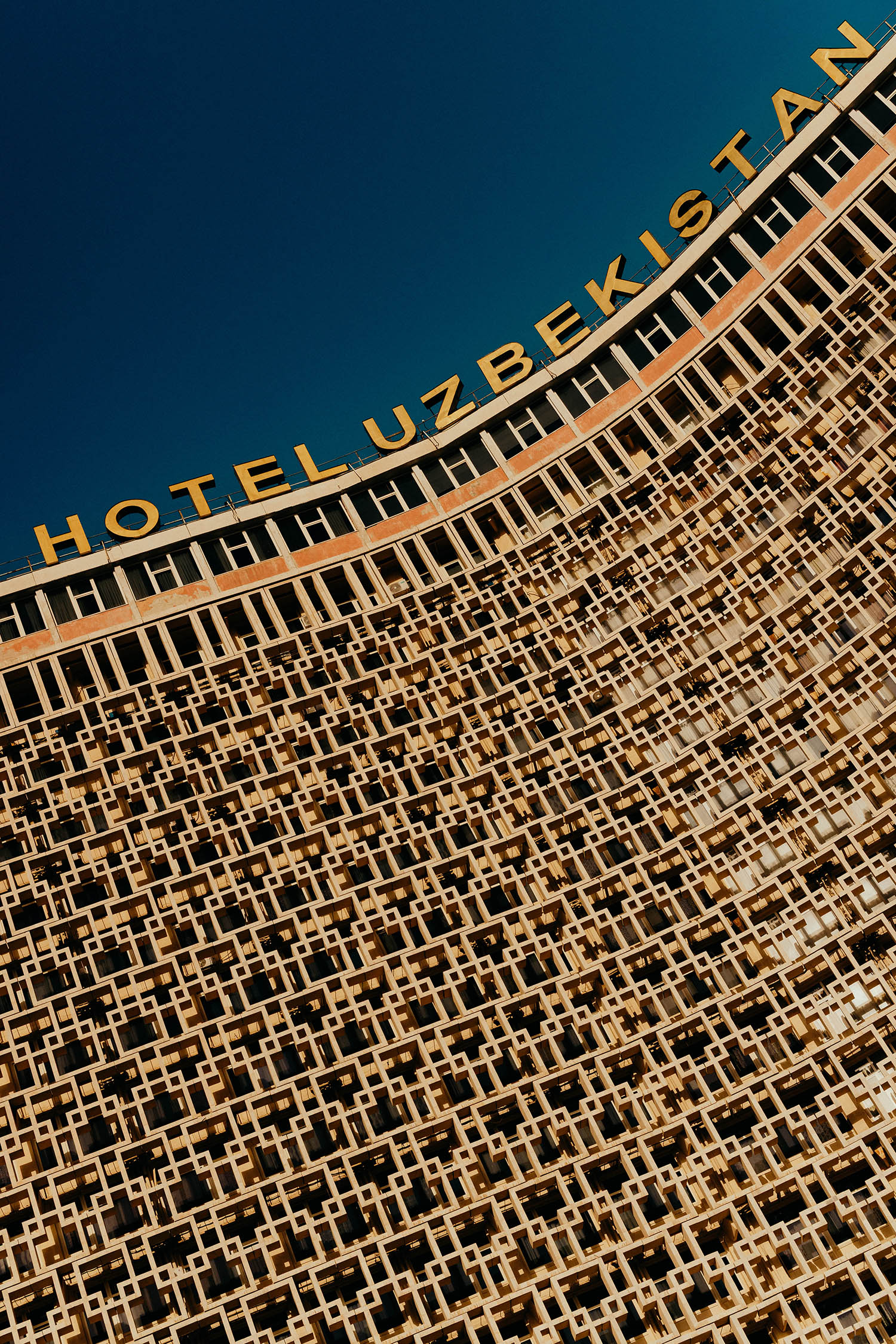
Winning patterns: the landmark Hotel Uzbekistan
The following day, tired of the pageantry, I decided to go underground. Tashkent was flattened by an earthquake in 1966 and rebuilt as a model Soviet city, beginning with its resplendent Moscow-style metro. At Kosmonavtlar station, mossy green chandeliers lit up deep blue mosaic portraits of Russian cosmonauts. At Alisher Navoi, beneath its geometric, mosque-like domes, watching departing trains painted the same teal as the tiles on the Gur-e-Amir, I had my first religious experience on a subway platform.
Above ground, tucked behind London plane trees on military parade boulevards, the city’s architecture proved just as eccentric. There was the Alisher Navoi cinema, a windowless building like a denuded, fluted column, and the landmark Hotel Uzbekistan, with its concrete window lattice resembling a traditional wooden screen. Beef, lamb and horse meat curdled beneath the vast, tiled dome of Chorsu Bazaar – an intergalactic yurt – while on its mezzanine, I sniffed bags of green tea with rose petals and dried kaffir lime.
In the shadow of much older buildings, however, it was sometimes difficult to tell the real from the fake. Beside the city’s loveliest 16th-century madrassa loomed a colossal building, like a mosque scaled-up. The Center for Islamic Civilization, a crown jewel in Mirziyoyev’s cultural redevelopment plans, will house treasures such as the world’s oldest Qur’an and a fragment of the kiswa, the black silk covering on the Kaaba in Mecca, donated by the king of Saudi Arabia.
The CCA artist residencies are located across a freshly paved highway from the Center, in a building designed to look half a millennium old. Every building within eyesight seemed newly ancient: coffee shops and unfinished mahallas in traditional brick with timber finishes. That is, until our driver took a wrong turn down a backstreet and a large neighbourhood opened up, all tin-roofed houses and low-slung powerlines. The area along the highway had been demolished, perhaps to hide a real suburb from tourists and visiting dignitaries. But here, children kicked a football across a dusty road, old men drank tea beneath an arbour. Life carried on, as it always had, behind the façade of a Potemkin village.
Beneath mosque-like domes, watching trains painted the same teal as the Gur-e-Amir, I had my first religious experience on a subway platform
My discovery was a sign of things to come. Later that week, after an hour’s flight, I arrived in the ancient desert city of Bukhara for the opening of the biennial. Scarecrows holding wooden Kalashnikovs greeted us on the baking tarmac. “There’s been a power outage,” Cyril Zammit, a French consultant for ACDF, told me on the bus ride into town. “But you’ll get to see the biennial very shortly.” He explained that the roads had recently been pedestrianised, and local residents were not happy about the mess. “It’s been a war zone for eight months,” he said.
The tightly woven streets of Old Bukhara lie at the centre of a desolate, half-built sprawl like the pearl in an oyster shell. Designated a World Heritage Site in 1993, that pearl has been scrubbed of its sand. During lockdown, paving stones were pulled up to bury pipes and electrical wiring. New construction follows ancient styles. The initial effect is splendid enough to induce Stendhal syndrome in the most cynical of travellers. With or without the biennial, it is a peerless permanent exhibition.
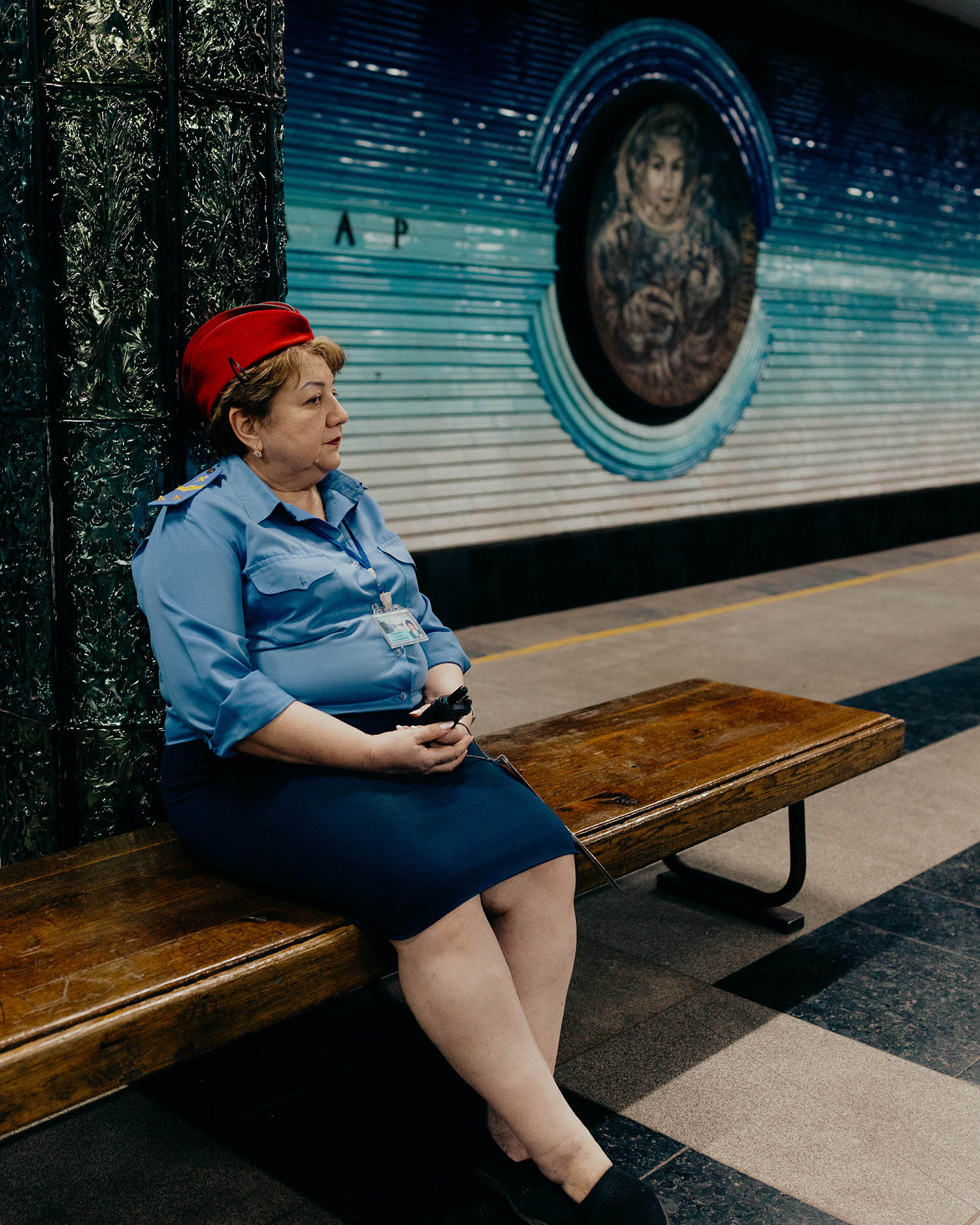
Tickets please: a metro guard at Kosmonavtlar station
Scale is hard to ascertain beneath the great blue masjid of a cloudless sky. The Ark of Bukhara, a fortress begun in the 5th century AD, towers over one end of town, unfurling its turreted walls in the tawny light like a vision from Arakkis. From its parapet, the view reveals a skyline dotted with brick minarets, from the four blue-capped towers of the Chor Minor to the intricately tiled Kalan Mosque, where a murmuration of starlings sang their own call to prayer.
The artworks in the biennial were dispersed between these buildings in covered bazaars and in the small, vaulted rooms of caravanserai, lodgings for Silk Road traders and their camels. Here, centuries ago, Indian and Jewish merchants traded spices with travellers from as far as Korea. Now, exhibition maps were being distributed from small conical kiosks coated in turmeric and coriander, which filled the air with their pungent aroma.
Scale is hard to ascertain beneath the great blue masjid of a cloudless sky
Bukhara joins more than 200 contemporary art biennials around the world, from Liverpool to Taipei. Diana Campbell, the show’s American curator, also organises one in Dhaka. Local governments and tourism boards favour them as lures for a wealthy art-world jet set, which also means they’re often harbingers of gentrification. The occasional sight of a White Cube tote bag at the opening gave Old Bukhara a slightly sanitised, toytown feel.
“The biennial is one way to demonstrate over time that these spaces can have a viable, non-commercial use,” said the Lebanese architect Wael al Awar, who was hired by ACDF to restore them. We were sitting in a pavilion made of metal pots by the Indian artist Subodh Gupta, who was cooking samosas at a counter inside. (Samosas originate from the Uzbek somsa, brought to the subcontinent in the 16th century by the Mughals, descendants of Tamerlane.) Unique to the biennial, each international artist was required to work with a local artisan. “These spaces also function to showcase those artisans’ work,” Al Awar said.
Behind us, a narrow canal flowed beneath lengths of hanging fabric made by the London-based Indian artist Himali Singh Soin in collaboration with Bukharan ikat weavers. The fabric was dyed with splotchy blue and purple forms – a timelapse of satellite imagery showing the Aral Sea, which dried up in the latter half of the 20th century. “The weavers had never worked with satellite images before, but ikat already looks pixelated,” Soin said. “It’s Uzbekistan’s viral image of climate change.”
Soin’s work was unusual for referencing a source of national trauma. Soin’s partner, the artist David Tappesen, filled a chamber with clay bird whistles, which we blew into a microphone, adding our tweets to a growing, recorded chorus that echoed around the caravenserai. Through a giant, turmeric-coated wooden pyramid, the courtyard of a madrassa had been filled with mud sculptures by Antony Gormley, which resembled Cubist tombstones when I encountered them beneath the bright light of a blood moon.
The effect was dazzling, though three days into the show, wall labels were still missing, so it was difficult to know who had made what. Artists described a painful installation process.
“It’s very exciting for the region, and the artists are celebrating, but for the people who really laboured on it, it has been traumatic,” an artist in the show, who declined to be named, confessed to me. We were sitting beside an ancient stepwell eating plov, the Uzbek national dish of rice stewed with lamb, onion and carrot, which was being cooked in steel drums for a local crowd. “They gave the artisans one month when they needed three,” she said.
Umerova, the ACDF chair, acknowledged that while it hadn’t been perfect, it was more than a start. “For the past 30 years, there has really been no development of the culture sphere,” she told me. “We are proud of our ancestors, but our cultural identity has been stuck in the past.”
We had caught a brief, shady moment of quiet in a madcap schedule of talks, lunches, and a loud procession of embroidered camel puppets. Umerova was sipping from a pint of iced coffee, looking around at local families who had come to enjoy the biennial for the day. Several children were admiring a shelter made of crystallised sugar, which had grown sticky in the heat. For many of them, the biennial would be their first experience of contemporary art. Umerova seemed pleased by the fact. “We have been able to become stabilised, and more or less financially independent, as we have natural resources to sustain us,” she said. “But we hadn’t realised our human resources.”
On the last day of my visit, suffering slightly from a bout of art-induced retinal fatigue, I stopped at a café in search of lagman, a dish of spicy hand-pulled noodles. It was busy on the terrace and the restaurant staff appeared unprepared for the crowd. Uneven development for tourists and not locals could easily overwhelm a place like this. Bukhara is once again at a crossroads.
Cyril, the French consultant, was at an adjacent table with a woman he introduced as a local colleague from ACDF. My order was delayed, so I asked her to teach me to say something in Uzbek to help speed it up.
“Menda aloqalar bor,” she replied. “The most important words here.”
“What do they mean?” I asked.
She smiled. “It means, ‘I have connections.’”
This article has been updated since publication
